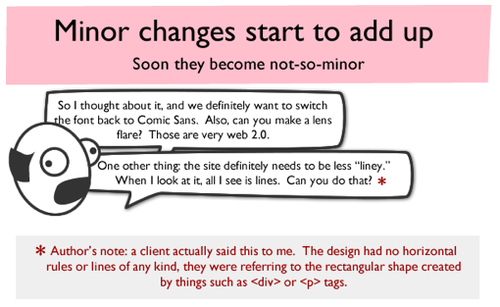
Does Writing an RFP Make You a Web Developer?
Most web development RFP's are a waste of time and I'm going to illustrate why.
Have you ever bought a custom home that you built from the ground up? If so, then you probably knew what color paint you wanted, what type of carpet and counter tops and maybe even the number of rooms and how many square feet you needed.
 You might have even gone so far as to find photos to support the type of look you wanted because, cosmetically, you had a pretty good idea of what you wanted to achieve. Now, lets be honest, finding advice and tips are rather easy to do, even for a novice. It doesn’t take too long; plus, you probably already have decent taste and a basic understanding of design.
That being said, if you’ve been through the process and actually did your homework then you know just how tedious and time consuming the aforementioned tasks can be. Now, for all the time, effort and energy you put in, did you..
You might have even gone so far as to find photos to support the type of look you wanted because, cosmetically, you had a pretty good idea of what you wanted to achieve. Now, lets be honest, finding advice and tips are rather easy to do, even for a novice. It doesn’t take too long; plus, you probably already have decent taste and a basic understanding of design.
That being said, if you’ve been through the process and actually did your homework then you know just how tedious and time consuming the aforementioned tasks can be. Now, for all the time, effort and energy you put in, did you..
- Create the blueprints for your home?
- Determine what type of wiring needed to be included?
- How many outlets you needed?
- Where to put in ceiling fan drops?
- How to run the water and drainage piping?
 Screenshot from The Oatmeal. Check out the full web comic!
A great interactive agency understands that a great website begins with a solid road map (or blueprint) - not just pretty pictures and cool features. At LevelTen, we try to help our clients maximize their potential for success. We do this by utilizing a process that allows us to explore every opportunity to deliver ROI; often times in doing so we have to work outside the parameters of an RFP.
Don’t get me wrong, in certain instances I completely understand the need for changes, but most of the time it’s closer to a homeowner telling the architect how to do their job. It really doesn't make any sense.
What's your opinion of RFP's? Should they be followed to the letter, or is there room for extra creativity? What should the role of the client be in this process?
Photo Credit
Screenshot from The Oatmeal. Check out the full web comic!
A great interactive agency understands that a great website begins with a solid road map (or blueprint) - not just pretty pictures and cool features. At LevelTen, we try to help our clients maximize their potential for success. We do this by utilizing a process that allows us to explore every opportunity to deliver ROI; often times in doing so we have to work outside the parameters of an RFP.
Don’t get me wrong, in certain instances I completely understand the need for changes, but most of the time it’s closer to a homeowner telling the architect how to do their job. It really doesn't make any sense.
What's your opinion of RFP's? Should they be followed to the letter, or is there room for extra creativity? What should the role of the client be in this process?
Photo Credit
